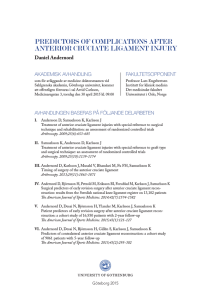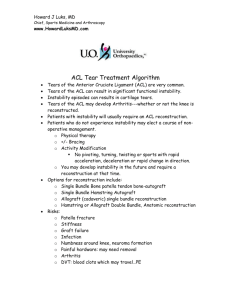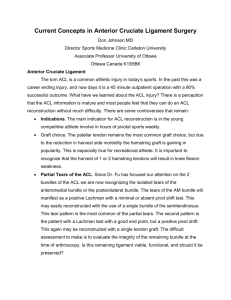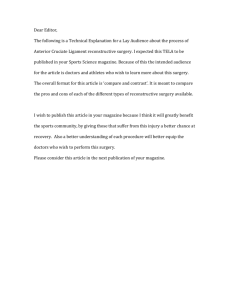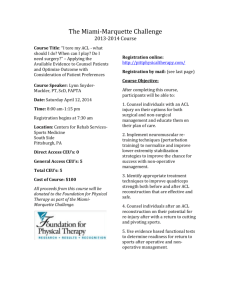Outcome of anatomic transphyseal anterior cruciate ligament
advertisement
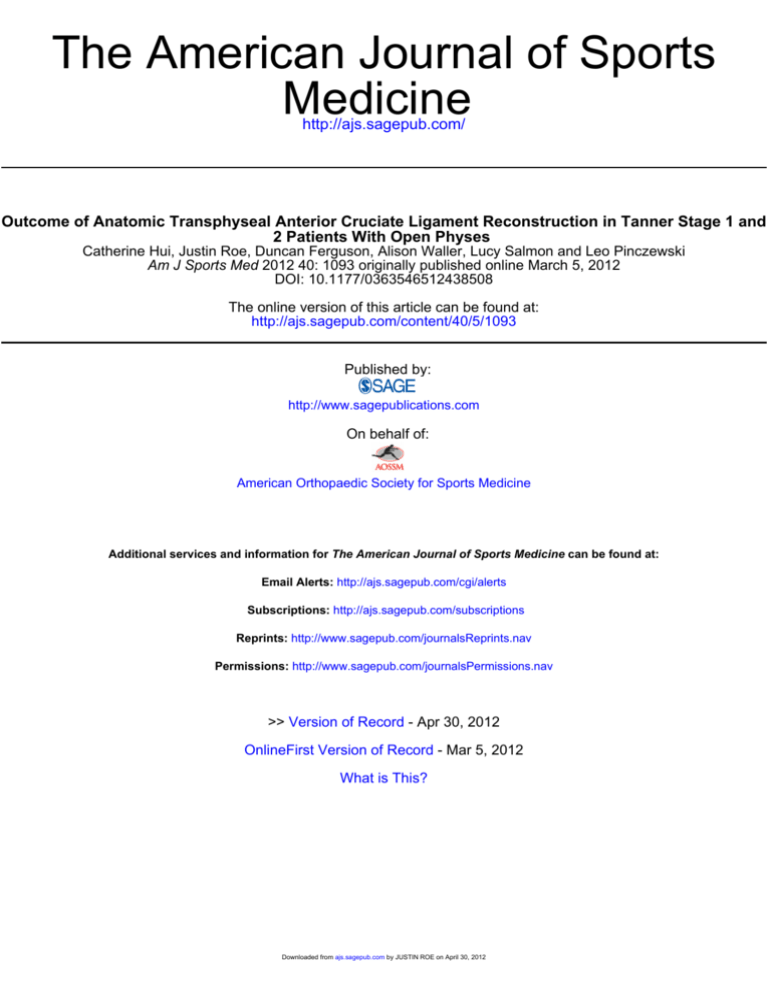
The American Journal of Sports Medicine http://ajs.sagepub.com/ Outcome of Anatomic Transphyseal Anterior Cruciate Ligament Reconstruction in Tanner Stage 1 and 2 Patients With Open Physes Catherine Hui, Justin Roe, Duncan Ferguson, Alison Waller, Lucy Salmon and Leo Pinczewski Am J Sports Med 2012 40: 1093 originally published online March 5, 2012 DOI: 10.1177/0363546512438508 The online version of this article can be found at: http://ajs.sagepub.com/content/40/5/1093 Published by: http://www.sagepublications.com On behalf of: American Orthopaedic Society for Sports Medicine Additional services and information for The American Journal of Sports Medicine can be found at: Email Alerts: http://ajs.sagepub.com/cgi/alerts Subscriptions: http://ajs.sagepub.com/subscriptions Reprints: http://www.sagepub.com/journalsReprints.nav Permissions: http://www.sagepub.com/journalsPermissions.nav >> Version of Record - Apr 30, 2012 OnlineFirst Version of Record - Mar 5, 2012 What is This? Downloaded from ajs.sagepub.com by JUSTIN ROE on April 30, 2012 Outcome of Anatomic Transphyseal Anterior Cruciate Ligament Reconstruction in Tanner Stage 1 and 2 Patients With Open Physes Catherine Hui,* MD, FRCSC, Justin Roe,* MBBS, FRACS, Duncan Ferguson,* MBChB, FRACS, Alison Waller,* BMedSci (Hons), BAppSci (Physio), Lucy Salmon,* BAppSci (Physio), PhD, and Leo Pinczewski,*zy MBBS, FRACS Investigation performed at the North Sydney Orthopaedic and Sports Medicine Centre, Wollstonecraft, Australia Background: Anterior cruciate ligament (ACL) injuries are being seen with increasing frequency in children. Treatment of the ACLdeficient knee in skeletally immature patients is controversial. Purpose: To determine the outcome of all-arthroscopic transphyseal anatomic single-bundle ACL reconstruction in Tanner stage 1 and 2 patients at a minimum of 2 years after surgery. Study Design: Case series; Level of evidence, 4. Methods: Between 2007 and 2008, 16 prepubescent patients underwent ACL reconstruction using soft tissue grafts. All patients were Tanner stage 1 and 2. Outcomes were assessed at a minimum of 2 years after surgery and included limb alignment, limb length, instrumented testing with the KT-1000 arthrometer, and International Knee Documentation Committee (IKDC) score. Results: Mean age at the time of surgery was 12 years (range, 8-14 years). Graft choices included the following: living donor– related hamstring tendon allograft (n = 14), hamstring tendon autograft (n = 1), and fresh-frozen allograft (n = 1). Mean IKDC subjective score was 96 (range, 84-100). All patients had a stable knee postoperatively. Eleven patients had a negative Lachman test result, and 14 had a negative pivot-shift test result. The remainder had grade 1 Lachman and pivot-shift test findings, respectively. At 2 years after surgery, all patients had returned to strenuous activities, and normal or nearly normal overall IKDC score was documented in 94% of patients. There were no cases of limb malalignment or growth arrest. Conclusion: We present a case series of transphyseal anatomic single-bundle ACL reconstruction in Tanner stage 1 and 2 patients at a minimum of 2 years after surgery. Excellent clinical outcomes were obtained with high levels of return to desired activities. Importantly, no growth disturbances were seen in this series of patients. Keywords: anterior cruciate ligament (ACL); injury; reconstruction; open physes; juvenile injuries.8,33 Commonly, these injuries are bony avulsion injuries of the ACL from its insertion on the tibial plateau, which are generally treated with open reduction and internal fixation of the fracture. Initially, intrasubstance ACL ruptures were thought to be rare in children; however, they are now becoming more commonly recognized in patients with open growth plates.2,3,14,19,27,31 Proper diagnosis and timely recognition of these injuries are necessary for appropriate treatment and prevention of future meniscal or chondral injuries. Treatment of ACL ruptures in children is controversial. A major concern in the treatment of these injuries in children is the growth plate. Injury to the growth plate can cause limb malalignment and limb length discrepancy, including both growth arrest and overgrowth.4,12,14,19 Treatment options for ACL ruptures in children include nonoperative treatment consisting of education and activity modification until physeal closure, ligament repair, Anterior cruciate ligament (ACL) injuries are occurring with increasing frequency in skeletally immature patients, as there are more children participating in high-risk sports. Furthermore, arthroscopy and magnetic resonance imaging (MRI) have improved the identification of these y Address correspondence to Leo Pinczewski, MBBS, FRACS, North Sydney Orthopaedic and Sports Medicine Centre, 3 Gillies Street, Suite 2, Wollstonecraft, NSW 2065, Australia (e-mail: lpinczewski@nsosmc .com.au). *Mater Clinic, North Sydney Orthopaedic and Sports Medicine Centre, Wollstonecraft, Australia. z University of Notre Dame, Sydney, Australia. Presented at the interim meeting of the AOSSM, San Diego, California, February 2011. The authors declared that they have no conflicts of interest in the authorship and publication of this contribution. The American Journal of Sports Medicine, Vol. 40, No. 5 DOI: 10.1177/0363546512438508 Ó 2012 The Author(s) 1093 Downloaded from ajs.sagepub.com by JUSTIN ROE on April 30, 2012 1094 Hui et al The American Journal of Sports Medicine nonanatomic extra-articular tenodesis procedures, physeal-sparing epiphyseal reconstructions, partial transphyseal procedures, and transphyseal (conventional) ACL reconstruction.17,27,31 Previous studies have reported safe and effective results of transphyseal ACL reconstruction in skeletally immature patients. However, the majority of these studies have been in Tanner stage 3 to 5 patients with closing physes.1,2,23 The purpose of this study was to determine the outcome of all-arthroscopic transphyseal anatomic single-bundle ACL reconstruction with a soft tissue graft in Tanner stage 1 and 2 patients at a minimum of 2 years after surgery. The graft was fixed with the knee in full hyperextension. Femoral fixation included the round-headed cannulated interference screw (n = 7) (RCI, Smith & Nephew, Andover, Massachusetts), Endobutton (n = 8) (Smith & Nephew), and staple (n = 1). Tibial fixation included the RCI screw (n = 2) (Smith & Nephew), staple (n = 13), and post fixation (n = 1). Staple fixation was done using the belt-buckle technique. Full hyperextension and stable Lachman and anterior drawer test results were achieved in all patients. Routine radiographs were obtained postoperatively. Postoperative Regimen MATERIALS AND METHODS Between 2007 and 2008, 16 skeletally immature patients underwent all-arthroscopic anatomic transphyseal singlebundle ACL reconstruction. All procedures were performed by 2 experienced knee surgeons (LP, JR). The 16 patients were Tanner stage 1 or 2. Exclusion criteria included previous surgery and/or previous injury to either knee or leg. All patients were assessed preoperatively with clinical examination for ACL ruptures with positive anterior drawer, Lachman, and pivot-shift test results.20 These were confirmed by examination under anesthesia. Tanner stage21,22 was documented at the time of surgery. Operative Technique Arthroscopic transphyseal anatomic single-bundle ACL reconstruction through a low anteromedial portal was performed using a soft tissue graft. The specific graft used was decided upon preoperatively after discussion with the patient and parents. Graft choices included living donor– related hamstring tendon allograft (n = 14), hamstring tendon autograft (n = 1), and fresh-frozen allograft (n = 1). All patients with living donor–related allografts underwent histocompatibility testing including Rh status. Any Rhnegative girls were given the appropriate dose of Rh immunoglobulin to prevent Rh sensitization. Appropriate graft size was determined intraoperatively based on the size of the patient. Therefore, of the living donor–related hamstring allografts, there were six 2-stranded gracilis, four 2-stranded semitendinosus, and four 4-stranded grafts used. A diagnostic arthroscopic procedure was performed first, using high anterolateral and low anteromedial portals. Suturing of appropriate meniscal lesions was carried out using an all-inside technique. Meniscal tears thought to have ‘‘good prognosis’’ by the surgeon at the time of surgery were left alone. These included short tears in the peripheral red-red zone and red-white zone that were partial thickness or stable to probing. The femoral tunnel was positioned 5 mm anterior to the posterior capsule insertion and was drilled through the low anteromedial portal with the knee in 100° to 110° of flexion to enable more perpendicular crossing of the femoral physis. The tibial tunnel was drilled to emerge in the ACL footprint, with the tunnel crossing the tibial physis as perpendicularly as possible. Immediate weightbearing with the aid of crutches was encouraged after surgery. Rehabilitation commenced on postoperative day 1 with the goal of achieving full extension by 14 days. The rehabilitation program included closed chain exercises with an emphasis on proprioceptive training. Return to competitive sport involving jumping, pivoting, or sidestepping was not permitted until 6 to 9 months after surgery depending on adherence to the rehabilitation protocol and achievement of postoperative goals. Assessment Assessments were performed by an independent, experienced physical therapist (L.S., A.W.). Clinical assessment included range of motion, ligament stability, and instrumented knee testing using the KT-1000 arthrometer (MEDmetric Corp, San Diego, California) and the manual maximum test. The International Knee Documentation Committee (IKDC) Knee Ligament Evaluation Form (2001) was used for clinical and subjective evaluations. Ligament stability was measured by the Lachman and pivot-shift tests. The Lachman grades were as follows: 0 (\3-mm laxity), 1 (3- to 5-mm laxity), or 2 (.5-mm laxity); the pivot-shift test was graded as 0 (negative), 1 (glide), 2 (clunk), or 3 (gross). Level of sporting activity was assessed according to IKDC levels 1 through 4, which correspond respectively to strenuous (rugby, basketball), moderate (skiing, tennis, heavy manual labor), light (jogging), and sedentary activities. The single-legged hop test was used for functional assessment. Evaluation was conducted preoperatively; at 6 weeks, 1 year, and 2 years postoperatively; and then annually until skeletal maturity. At a mean of 26 months, 4-foot standing alignment radiographs were performed at 2 years postoperatively. An experienced surgeon with training in knee surgery (DF) measured limb alignment on 15 long leg radiographs. RESULTS Sixteen Tanner stage 1 and 2 patients with open growth plates underwent arthroscopic anatomic transphyseal ACL reconstruction between 2007 and 2008. Mean followup time was 25 months (range, 21-34 months). There Downloaded from ajs.sagepub.com by JUSTIN ROE on April 30, 2012 Vol. 40, No. 5, 2012 ACL Reconstruction in Tanner Stage 1 and 2 Patients 1095 TABLE 1 ACL Injury Frequency by Sporta Sport Soccer Motorcycle Playground Rugby AFL Basketball Cycling Skiing Trampoline Unknown Frequency % 4 2 2 2 1 1 1 1 1 1 25 12.5 12.5 12.5 6.3 6.3 6.3 6.3 6.3 6.3 a ACL, anterior cruciate ligament; AFL, Australian Football League. were 12 boys (75%) and 4 girls (25%). The left side was involved in 5 patients (31%) and the right in 11 (69%). Mean age at the time of surgery was 12 years (range, 814 years). Reconstruction was performed within 3 weeks of injury in 1 patient (6%), between 3 and 12 weeks in 8 (50%), and after 12 weeks in 7 (44%). The principal causes of injury were soccer (25%), rugby (12.5%), playground accident (12.5%), motorcycle accident (12.5%), and other sports (38%) (Table 1). Operative Findings Nine patients (56%) had intact menisci at the time of ACL reconstruction. Four patients (25%) had documented meniscal injuries, which had good prognosis after joint stabilization and were left untreated. A further 3 (19%) patients required lateral meniscal sutures at the time of surgery. No patients underwent meniscectomy. Clinical, Functional, and Subjective Assessments Postoperatively, all patients had normal alignment compared with the contralateral noninjured leg on clinical assessment. There was no clinically significant leg length discrepancy. No patients had an effusion present at 2 years postoperatively. Mean flexion was 138° (range, 130°-150°). Fourteen patients (88%) had full extension, and 2 patients had \3° extension loss compared with the contralateral limb. At 2-year follow-up, all patients had a stable knee. Eleven patients (69%) had a negative Lachman test finding, and the remainder (31%) had a grade 1 Lachman test result with a firm end point. Fourteen patients (88%) had a negative pivot-shift test finding, and 2 patients (12%) had a pivot glide. Ten patients (63%) had 3-mm side-to-side difference on KT-1000 arthrometer instrumented testing. Five patients (31%) had 3- to 5-mm sideto-side difference, and 1 patient (6%) had .5 mm. The mean side-to-side difference on KT-1000 arthrometer manual maximum testing was 1.9 mm. On single-legged hop testing, 81% (13/16) of patients were able to hop .90% of the distance of the opposite knee. There were no patients with an ACL graft rupture, nor were there any patients with a contralateral ACL injury at the 2-year review. Mean Lysholm knee score was 97 (range, 90-100). Mean IKDC subjective score was 96 (range, 84-100). At 2 years after surgery, normal or nearly normal overall IKDC score was documented in 94% (15/16) of patients. All patients had returned to strenuous activities at the 2-year review. Radiographic Assessment All patients had open physes documented on radiographs preoperatively. On review, at a mean of 26 months, 15 patients’ standing alignment films were assessed. Ten patients had open physes, 4 patients had closing physes, and 1 patient had closed physes on radiographs. The mean mechanical axis was 9° valgus (range, 5°-13°) on the operative side and 10° valgus (range, 1°-13°) on the nonoperative side. The mean side-to-side difference in femoral-tibial angle between the operative limb and the contralateral noninjured limb was 1° (standard deviation [SD], 1°; range, –1° to 3°). DISCUSSION The treatment of intrasubstance ACL ruptures in children remains controversial. Nonoperative treatment of these injuries until physeal closure in this age group of patients is fraught with difficulty. Despite appropriate education and counseling regarding living within the envelope of stability, compliance remains an issue with children. Previous studies have shown that nonoperative treatment leads to instability,1 meniscal injury,7,10,31 and arthrosis.1 Primary ligament repair and extra-articular procedures have been shown to have poor results,5 and physeal sparing and partial transphyseal procedures often lead to nonanatomic reconstructions.23,24,28 The goal of any ACL reconstruction is a stable knee that allows early mobilization and accelerated rehabilitation. Historically, nonanatomic ACL reconstructions have also resulted in residual instability and further meniscal and chondral injuries, leading to arthrosis.23,24 It has also been shown that younger patients are at high risk for further ACL injury, both contralateral ACL ruptures and ACL graft ruptures.9,30 We have shown in our series of patients that transphyseal anatomic singlebundle reconstructions are successful, with no growth disturbances and all patients returning to preinjury levels of sport, and can be considered as a viable treatment option in these high-risk skeletally immature patients. There are few studies on ACL reconstruction in Tanner 1 and 2 patients in the literature. Many previous studies have focused on the adolescent and Tanner stage 3 to 5 patients. The safety of transphyseal ACL reconstructions in this more mature subset of skeletally immature patients has been well established.2,13 In prepubescent patients, there are only case series with small numbers of patients. Most of these studies report that extraphyseal ACL reconstruction procedures have no adverse effects.28 The largest Downloaded from ajs.sagepub.com by JUSTIN ROE on April 30, 2012 1096 Hui et al The American Journal of Sports Medicine case series in the literature on ACL reconstruction in Tanner stage 1 and 2 patients is by Kocher et al.13 They reviewed 44 patients who underwent physeal-sparing combined intra-/extra-articular ACL reconstruction using an autogenous iliotibial band (ITB) with a mean 5.3-year follow-up. There were no complications and no growth disturbances. Two patients required revision ACL reconstruction after traumatic rerupture during sports, and 4 other patients required further meniscal surgery. They concluded that this technique provided excellent functional outcomes with a low revision rate. Therefore, in their algorithm of the treatment of ACL injuries in skeletally immature patients, Kocher and colleagues have recommended transphyseal ACL reconstruction in the adolescent patient (Tanner stage 3-5), and in prepubescent patients (Tanner stage 1 and 2), they have recommended physeal sparing combined with intra-/extra-articular reconstruction using an ITB.12 Similar to Kocher,12 we recommend transphyseal ACL reconstruction in Tanner stage 3 to 5 patients. However, prepubescent patients have the highest risk for reinjury. As extra-articular and nonanatomic ACL reconstruction techniques have been abandoned in favor of more anatomic techniques with better outcomes in primary ACL reconstruction in adults, we believe that these more anatomic techniques should be considered in the high-risk prepubescent patient, and we recommend transphyseal anatomic single-bundle ACL reconstruction. We have shown in our study, along with several previous case series, the efficacy of transphyseal ACL reconstruction in these Tanner stage 1 and 2 patients. Liddle et al18 recently published their results on a series of 17 Tanner stage 1 and 2 patients undergoing transphyseal ACL reconstruction using an arthroscopically assisted technique. They had 1 traumatic rerupture and 1 patient with a mild valgus deformity. Of the remaining patients, all had stable knees on instrumented testing, and 94% had excellent results with a mean postoperative Lysholm score of 97.5 (SD, 2.6) and Tegner activity score of 7.9 (SD, 1.4).18 Fuchs et al6 reported no growth disturbance in a series of 10 patients with open physes undergoing transphyseal ACL reconstruction using patellar tendon allografts and interference screws carefully placed proximal to the growth plate. Ninety percent of the patients had normal or nearly normal outcomes on IKDC scoring, and the mean postoperative Lysholm score was 95.6 Like Fuchs and colleagues, we report excellent results in this series of skeletally immature patients with open physes treated with arthroscopic transphyseal anatomic single-bundle ACL reconstruction with a soft tissue graft. Potential growth plate injury leading to growth disturbance is the main cause for concern in ACL reconstruction in skeletally immature patients with open physes. This fear has affected the decision-making process of many surgeons treating these injuries. Despite these concerns, true growth disturbance related to ACL reconstruction in skeletally immature patients is rare. To our knowledge, there have been less than 20 reported cases of growth disturbances in the literature (Table 2). Kocher et al’s survey of the Herodicus Society and ACL Study Group in 2002 found that 11% (15/140) of respondents had seen a growth disturbance from an ACL reconstruction in a skeletally immature patient (Table 2).14 The most common deformity reported was valgus angulation of the lower extremity. Another concern is the ACL graft acting as a tether, leading to growth disturbance. Although Kocher et al report 2 cases of this in their survey related to extra-articular tethers of the lateral distal femoral physis,14 Aichroth et al1 have shown in a series of 47 transphyseal hamstring tendon reconstructions in skeletally immature patients that the graft becomes vascularized, demonstrated by the fixation devices growing away from the physes over time. We have demonstrated that even in very young Tanner stage 1 and 2 patients, an all-arthroscopic anatomic single-bundle ACL reconstruction using a soft tissue graft is a safe, effective procedure with no evidence of growth disturbance at a minimum 2 years’ follow-up. It has been well established that ACL reconstruction in children with open physes should be with soft tissue grafts, which avoids the risk of growth arrest because of bony block placement across the physis.31 There is no guarantee that any tissue across the growth plate can prevent growth disturbance; however, several studies have demonstrated that soft tissue interposition following resection of a bony bar in cases of partial physeal arrest can help prevent further bar formation.11,16,32 In addition, drill holes across the physis should be made as small as possible.31 Experimental animal studies suggest that more than 3% to 5% of the cross-sectional area of the physis has to be damaged to cause growth arrest.11,26 Therefore, in theory, a soft tissue graft across the growth plate, such as that used in ACL reconstruction, should not cause any growth disturbance.11,26 Soft tissue graft options include hamstring tendon autograft, living donor–related hamstring tendon allograft from the parents, and fresh-frozen allograft. The majority of the patients in this study had living donor– related hamstring tendon allograft. This procedure involves simultaneous hamstring tendon harvest in one operating theater with the ACL reconstruction in the adjacent theater. Reasons for this technique include more predictable size of the hamstring tendon compared with an autograft from the child; reduced risk of infectious disease transmission; decreased donor site morbidity; avoidance of disrupting the hamstrings, which are known secondary stabilizers to anterior tibial translation; and lastly, reserving the child’s own hamstrings for future operations, if necessary. The outcome of ACL reconstruction using living donor–related hamstring tendon allograft requires further study, and we intend to follow this group over the long term. We used a variety of fixation options in this study and recognize that this is a weakness of the study. Currently, there is no consensus on the best fixation for soft tissue grafts in ACL reconstruction surgery. Extracortical fixation has been recommended for graft fixation in patients with open growth plates to avoid any risk of growth disturbance.14 However, care must be taken to ensure the extracortical device is not too close to the physis, which may lead to a growth disturbance.31 In this study, we used interference screw fixation in the femur in 7 patients and in the Downloaded from ajs.sagepub.com by JUSTIN ROE on April 30, 2012 Vol. 40, No. 5, 2012 ACL Reconstruction in Tanner Stage 1 and 2 Patients 1097 TABLE 2 Summary of Growth Disturbances Reported in the Literaturea Author(s) No. of Cases Lipscomb and Anderson19 1 Koman and Sanders15 1 Kocher et al14 3 Reconstruction Technique Growth Disturbance Femur: epiphyseal Growth arrest (2-cm limb Tibia: transphyseal shortening) Graft: 4-strand G/ST autograft Femur: transphyseal Distal femoral physeal arrest Tibia: transphyseal (valgus deformity) Graft: 2-strand ST autograft — Distal femoral physeal arrest (valgus deformity) 3 Graft: BPTB Distal femoral physeal arrest (valgus deformity) 1 Graft: BPTB 1 Femur: over-the-top 2 — 1 1 Femur: transphyseal Tibia: transphyseal Graft: 6-mm HT autograft — Distal femoral physeal arrest (valgus deformity) Distal femoral physeal arrest (valgus deformity) Genu valgum (no bony bar formation) Overgrowth (3 cm) 2 — McIntosh et al25 1 Chotel et al4 2 Femur: transphyseal Tibia: transphyseal Graft: 4-strand G/ST autograft Femur: over-the-top (McIntosh) Overgrowth (1.5 cm and 1 cm) Tibia: transphyseal Graft: ITB Genu recurvatum (closure of tibial tubercle apophysis) Genu recurvatum (closure of tibial tubercle apophysis) Overgrowth (1.5 cm) Cause Stapling of both femoral and tibial physes Metal transfix device crossing lateral aspect of distal femoral physis Fixation device across physis (interference screw, transfix, staple) Bone plug from patellar tendon graft across lateral distal femoral physis Large (12 mm) femoral tunnel Over-the-top graft placement Lateral extra-articular tenodesis procedure — Staple across apophysis Suturing to tibial periosteum — — a G, gracilis; ST, semitendinosus; BPTB, bone–patellar tendon–bone; HT, hamstring tendon; ITB, iliotibial band. tibia in 2 patients without evidence of growth disturbance. The technique of insertion of interference screws in the femur involves carefully observing the screw head pass beyond the growth plate arthroscopically. Fuchs et al6 have previously described a similar technique using a patellar tendon bone block with interference screw fixation without any complications. The tibial tunnel is intentionally made as long as possible such that the hole in the physis is made as centrally as possible to prevent angular deformity with growth.31 With a long tibial tunnel, an interference screw can be used in the tibia with its final position remaining well away from the physis. We intend to follow this group of patients to skeletal maturity to ensure that no growth disturbance occurs. To our knowledge, this is the largest series of patients undergoing all-arthroscopic transphyseal anatomic singlebundle ACL reconstruction using an identical technique to that used in adult ACL reconstructions. Previous studies report fewer patients or use an arthroscopically assisted technique rather than an all-arthroscopic technique. Other strengths include 100% follow-up, which is often difficult to achieve in this group of patients. All procedures were performed by 2 experienced, highvolume knee surgeons using a similar technique. A trained unbiased orthopaedic surgeon performed all radiographic assessments. Weaknesses of this study include those inherent to its retrospective nature. There were multiple devices used for fixation as discussed previously, which demonstrates a general lack of consensus regarding fixation in ACL reconstruction. Another weakness was the wide range of KT-1000 arthrometer measurements, including one patient with a side-to-side difference of 8 mm. Clinically, this patient had a grade 1 Lachman test finding with a firm end point noted by 2 different physicians and a stable knee with the ability to return to competitive sports. While we recognize that this shows inconsistency in our arthrometer measurements, previous studies have questioned the interrater and intrarater reliability of the KT-1000 arthrometer, with better reliability found in the Lachman test.34 Third, limb length was assessed clinically rather than radiographically and therefore may not be as accurate. Lastly, mean follow-up time was 26 months with a minimum follow-up of 2 years. This is a relatively short-term follow-up; however, the outcome of interest in this specific group of skeletally immature patients with open growth plates is growth disturbance. While the exact period of observation for growth disturbances after growth plate injury is not known, Downloaded from ajs.sagepub.com by JUSTIN ROE on April 30, 2012 1098 Hui et al The American Journal of Sports Medicine it is recommended that follow-up should be for a minimum of 1 year, and in general, most growth disturbances will be seen.29 We are continuing to follow these patients and will be reporting their outcomes at skeletal maturity. However, in light of the increasing number of prepubescent patients with ACL injuries, we believe that this is an important topic of study and want to raise awareness to the importance of obtaining a stable knee in these young patients, with transphyseal reconstruction being a good treatment option. We present the largest series of all-arthroscopic transphyseal single-bundle ACL reconstruction in Tanner stage 1 and 2 patients at a minimum of 2 years following surgery. We have shown that this is a safe procedure in young children with intrasubstance ACL injuries. Excellent clinical outcomes were obtained with high levels of return to desired activities. Importantly, no growth disturbances were seen in this series of patients. 14. 15. 16. 17. 18. 19. 20. REFERENCES 21. 1. Aichroth PM, Patel DV, Zorrilla P. The natural history and treatment of rupture of the anterior cruciate ligament in children and adolescents: a prospective review. J Bone Joint Surg Br. 2002;84(1):38-41. 2. Aronowitz ER, Ganley TJ, Goode JR, Gregg JR, Meyer JS. Anterior cruciate ligament reconstruction in adolescents with open physes. Am J Sports Med. 2000;28(2):168-175. 3. Bales CP, Guettler JH, Moorman CT. Anterior cruciate ligament injuries in children with open physes evolving strategies of treatment. Am J Sports Med. 2004;32(8):1978-1985. 4. Chotel F, Henry J, Seil R, Chouteau J, Moyen B, Bérard J. Growth disturbances without growth arrest after ACL reconstruction in children. Knee Surg Sports Traumatol Arthros. 2010;18(11):1496-1500. 5. Engebretsen L, Svenningsen S, Benum P. Poor results of anterior cruciate ligament repair in adolescence. Acta Orthop Scand. 1988;59(6):684-686. 6. Fuchs R, Wheatley W, Uribe JW, Hechtman KS, Zvijac JE, Schurhoff MR. Intra-articular anterior cruciate ligament reconstruction using patellar tendon allograft in the skeletally immature patient. Arthroscopy. 2002;18(8):824-828. 7. Graf BK, Lange RH, Fujisaki CK, Landry GL, Saluja RK. Anterior cruciate ligament tears in skeletally immature patients: meniscal pathology at presentation and after attempted conservative treatment. Arthroscopy. 1992;8(2):229-233. 8. Haus J, Refior HJ. The importance of arthroscopy in sports injuries in children and adolescents. Knee Surg Sports Traumatol Arthros. 1993;1(1):34-38. 9. Hui C, Salmon LJ, Kok A, Maeno S, Linklater J, Pinczewski LA. Fifteen-year outcome of endoscopic anterior cruciate ligament reconstruction with patellar tendon autograft for ‘‘isolated’’ anterior cruciate ligament tear. Am J Sports Med. 2011;39(1):89-98. 10. Janarv P-M, Nyström A, Werner S, Hirsch G. Anterior cruciate ligament injuries in skeletally immature patients. J Pediatr Orthop. 1996;16(5):673-677. 11. Janarv P-M, Wikstrom B, Hirsch G. The influence of transphyseal drilling and tendon grafting on bone growth: an experimental study in the rabbit. J Pediatr Orthop. 1998;18(2):149-154. 12. Kocher MS. Anterior cruciate ligament reconstruction in the skeletally immature patient. Oper Tech Sports Med. 2006;14(3):124-134. 13. Kocher MS, Garg S, Micheli LJ. Physeal sparing reconstruction of the anterior cruciate ligament in skeletally immature prepubescent 22. 23. 24. 25. 26. 27. 28. 29. 30. 31. 32. 33. 34. children and adolescents. J Bone Joint Surg Am. 2005;87(11):2371-2379. Kocher MS, Saxon HS, Hovis WD, Hawkins RJ. Management and complications of anterior cruciate ligament injuries in skeletally immature patients: survey of The Herodicus Society and The ACL Study Group. J Pediatr Orthop. 2002;22(4):452-457. Koman JD, Sanders JO. Valgus deformity after reconstruction of the anterior cruciate ligament in a skeletally immature patient: a case report. J Bone Joint Surg Am. 1999;81(5):711-715. Langenskiold A. An operation for partial closure of an epiphysial plate in children, and its experimental basis. J Bone Joint Surg Br. 1975;57(3):325-330. Larsen MW, Garrett WE Jr, DeLee JC, Moorman CT III. Surgical management of anterior cruciate ligament injuries in patients with open physes. J Am Acad Orthop Surg. 2006;14(13):736-744. Liddle AD, Imbuldeniya AM, Hunt DM. Transphyseal reconstruction of the anterior cruciate ligament in prepubescent children. J Bone Joint Surg Br. 2008;90(10):1317-1322. Lipscomb AB, Anderson AF. Tears of the anterior cruciate ligament in adolescents. J Bone Joint Surg Am. 1986;68(1):19-28. Lubowitz JH, Bernardini BJ, Reid JB III. Current concepts review: comprehensive physical examination for instability of the knee. Am J Sports Med. 2008;36(3):577-594. Marshall WA, Tanner JM. Variations in pattern of pubertal changes in girls. Arch Dis Child. 1969;44(235):291-303. Marshall WA, Tanner JM. Variations in the pattern of pubertal changes in boys. Arch Dis Child. 1970;45(239):13-23. McCaroll JR, Retting AC, Shelbourne KD. Anterior cruciate ligament injuries in the young athlete with open physes. Am J Sports Med. 1988;16:44-47. McCarroll JR, Shelbourne KD, Porter DA, Rettig AC, Murray S. Patellar tendon graft reconstruction for midsubstance anterior cruciate ligament rupture in junior high school athletes. Am J Sports Med. 1994;22(4):478-484. McIntosh AL, Dahm DL, Stuart MJ. Anterior cruciate ligament reconstruction in the skeletally immature patient. Arthroscopy. 2006;22(12):1325-1330. Nordentoft EL. Experimental epiphyseal injuries: grading of traumas and attempts at treating traumatic epiphyseal arrest in animals. Acta Orthop Scand. 1969;40(2):176-192. Paletta GA Jr. Special considerations: anterior cruciate ligament reconstruction in the skeletally immature. Orthop Clin North Am. 2003;34(1):65-77. Parker AW, Drez D Jr, Cooper JL. Anterior cruciate ligament injuries in patients with open physes. Am J Sports Med. 1994;22(1):44-47. Salter RB, Harris WR. Injuries involving the epiphyseal plate. J Bone Joint Surg Am. 1963;45(3):587-622. Shelbourne KD, Gray T, Haro M. Incidence of subsequent injury to either knee within 5 years after anterior cruciate ligament reconstruction with patellar tendon autograft. Am J Sports Med. 2009;37(2):246251. Simonian PT, Metcalf MH, Larson RV. Anterior cruciate ligament injuries in the skeletally immature patient. Am J Orthop. 1999;28(11):624628. Stadelmaier DM, Arnoczky SP, Dodds J, Ross H. The effect of drilling and soft tissue grafting across open growth plates. Am J Sports Med. 1995;23(4):431-435. Wessel LM, Scholz S, Rüsch M, et al. Hemarthrosis after trauma to the pediatric knee joint: what is the value of magnetic resonance imaging in the diagnostic algorithm? J Pediatr Orthop. 2001;21(3):338-342. Wiertsema SH, van Hooff HJ, Migchelsen LA, Steultjens MP. Reliability of the KT1000 arthrometer and the Lachman test in patients with an ACL rupture. Knee. 2008;15(2):107-110. For reprints and permission queries, please visit SAGE’s Web site at http://www.sagepub.com/journalsPermissions.nav Downloaded from ajs.sagepub.com by JUSTIN ROE on April 30, 2012
